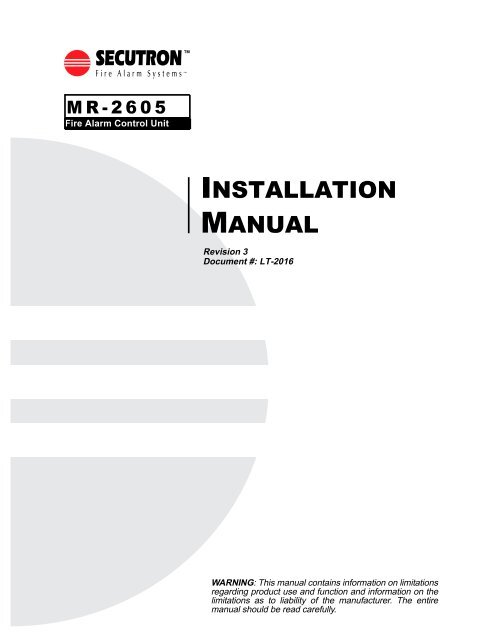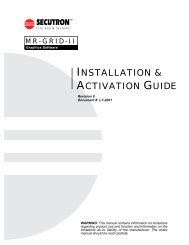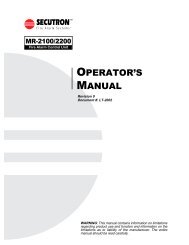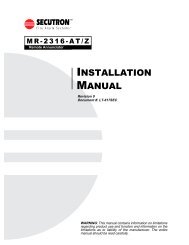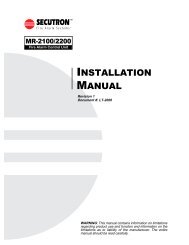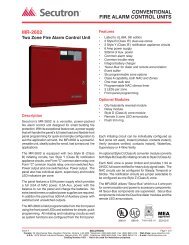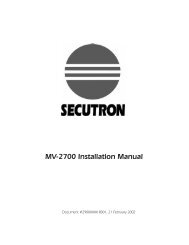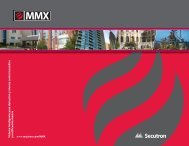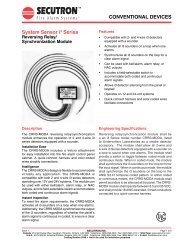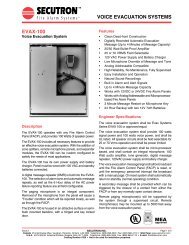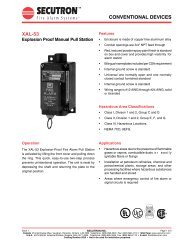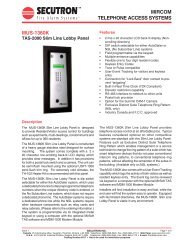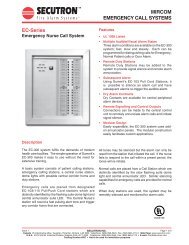LT-2016 MR-2605 Installation Manual Rev.3 - Secutron
LT-2016 MR-2605 Installation Manual Rev.3 - Secutron
LT-2016 MR-2605 Installation Manual Rev.3 - Secutron
You also want an ePaper? Increase the reach of your titles
YUMPU automatically turns print PDFs into web optimized ePapers that Google loves.
<strong>MR</strong>-<strong>2605</strong>Fire Alarm Control UnitI NSTALLATIONM ANUALRev i sion 3Document #: <strong>LT</strong>-<strong>2016</strong>WARNING : This manual contains information on limitationsregarding product use and function and information on thelimitations as to liability of the manufacturer. The entiremanual should be read carefully.
<strong>MR</strong>-<strong>2605</strong> <strong>Installation</strong> and Operator’s <strong>Manual</strong>Table of Contents1.0 Introduction ...................................................................................................................... 11.1 The <strong>MR</strong>-<strong>2605</strong> Fire Alarm Control Unit ........................................................................... 11.2 Codes, Standards and <strong>Installation</strong> Requirements ......................................................... 11.3 Technical Support and General Information ................................................................. 21.4 System Verification ....................................................................................................... 21.5 Standby Power .............................................................................................................. 21.6 Battery Maintenance ..................................................................................................... 22.0 Preparing to Install the <strong>MR</strong>-<strong>2605</strong> Fire Panel .................................................................. 32.1 Unpacking the <strong>MR</strong>-<strong>2605</strong> ............................................................................................... 32.2 Optional Accessories .................................................................................................... 42.3 <strong>MR</strong>-<strong>2605</strong> Overview ...................................................................................................... 52.4 Planning Your <strong>Installation</strong> ............................................................................................. 62.5 Electrical Specifications ................................................................................................ 62.6 Module Current Ratings ................................................................................................ 72.7 Standby Battery calculation chart .................................................................................. 72.8 Calculation for Standby Battery Requirement ............................................................... 83.0 Installing the <strong>MR</strong>-<strong>2605</strong> Fire Panel ................................................................................... 103.1 Environmental Specifications ........................................................................................ 103.2 Panel Assembly and Modules Locations ...................................................................... 103.3 Mounting the <strong>MR</strong>-<strong>2605</strong> .................................................................................................. 114.0 Wiring the <strong>MR</strong>-<strong>2605</strong> .......................................................................................................... 124.1 Wiring Specifications ..................................................................................................... 124.2 Connecting NAC Devices (Class ‘A’ and Class ‘B’) ...................................................... 145.0 Panel Operation ................................................................................................................ 185.1 Operating Sequences ................................................................................................... 185.2 General Zone Fire Alarms ............................................................................................. 185.3 Waterflow Alarms .......................................................................................................... 185.4 Supervisory Zone Alarms .............................................................................................. 195.5 Trouble Operation ......................................................................................................... 195.6 System Reset Operation ............................................................................................... 215.7 Lamp Test ..................................................................................................................... 215.8 Walk Test (Installer function only) ................................................................................. 225.9 NAC operation ............................................................................................................... 235.10 Relay Function ............................................................................................................ 236.0 Programming the <strong>MR</strong>-<strong>2605</strong> System ................................................................................ 246.1 How to Program the <strong>MR</strong>-<strong>2605</strong> ...................................................................................... 246.2 Programming Section Descriptions ............................................................................... 266.3 Viewing the Event Buffer ............................................................................................... 297.0 Startup of the <strong>MR</strong>-<strong>2605</strong> .................................................................................................... 317.1 Prior to power up ........................................................................................................... 317.2 Power up sequence ...................................................................................................... 317.3 Default Operation .......................................................................................................... 317.4 Programming the Panel ................................................................................................ 317.5 Final Verification ............................................................................................................ 318.0 Programming Worksheets ............................................................................................... 328.1 Entering Programming Mode ........................................................................................ 328.2 Zone Programming (Section 0) ..................................................................................... 338.3 NAC Temporal/Steady Programming (Section 1) ......................................................... 338.4 NAC Auto-silence, Strobe Programming (Section 2) .................................................... 338.5 Silence Inhibit and Walk Test Programming (Section 3) ............................................... 348.6 Waterflow Programming (Section 4) ............................................................................. 348.7 50/60Hz Option (Section 5) ........................................................................................... 34i
<strong>MR</strong>-<strong>2605</strong> <strong>Installation</strong> and Operator’s <strong>Manual</strong>9.0 Appendix: Table of Compatible Smoke Detectors ........................................................ 359.1 Smoke Detector Bases ................................................................................................. 379.2 Compatible 4-Wire Smoke Detectors ............................................................................ 379.3 Compatible Horns/Strobes ............................................................................................ 37FCC Compliance Statement .................................................................................................. 40Warranty & Warning Information .......................................................................................... 41ii
<strong>MR</strong>-<strong>2605</strong> <strong>Installation</strong> and Operator’s <strong>Manual</strong>List of FiguresFigure 1: <strong>MR</strong>-<strong>2605</strong> cabinet with door closed ....................................................................... 5Figure 2: <strong>MR</strong>-<strong>2605</strong> display and controls ............................................................................. 5Figure 3: <strong>MR</strong>-<strong>2605</strong> Cabinet Overview ................................................................................. 5Figure 4: Zone Label Insert ................................................................................................. 5Figure 5: Panel Assembly and Modules Locations ............................................................. 10Figure 6: Mounting Dimensions .......................................................................................... 11Figure 7: Knockout Locations .............................................................................................. 11Figure 8: <strong>MR</strong>-<strong>2605</strong> Terminal Descriptions .......................................................................... 12Figure 9: Connecting 2-Wire Alarm Initiating Devices ......................................................... 13Figure 10: Connecting 4-Wire Smoke Detectors ................................................................. 14Figure 11: Connecting NAC Devices (Class ‘B’) ................................................................. 14Figure 12: Connecting NAC Devices (Class ‘A’) ................................................................. 14Figure 13: Connecting Batteries .......................................................................................... 15Figure 14: Connecting AC Power ........................................................................................ 15Figure 15: Connecting the Alarm and Trouble Relays ........................................................ 16Figure 16: Connecting Optional Devices ............................................................................. 16Figure 17: Locating the Walk Test Switch ........................................................................... 24iii
<strong>MR</strong>-<strong>2605</strong> <strong>Installation</strong> and Operator’s <strong>Manual</strong>1.0 Introduction1.1 The <strong>MR</strong>-<strong>2605</strong> Fire Alarm Control UnitGeneral features•Five initiating device circuits, class B / style B•Two notification appliance circuits, class B / style Y (Power Limited)[can be wired as one NAC, class A / style Z]•One common alarm-actuated relay, form ‘C’•One common trouble-actuated relay, form ‘C’•AUX+ power output, 500 mA max. (Power Limited)•Unswitched common and switched common auxiliary power returns•Integral battery charger•Cabinet with dead-front construction•Transformer, mounted in the cabinetApplicationsThe <strong>MR</strong>-<strong>2605</strong> five zone, fire alarm control panel is listed for use in the following applications.•Protected Premises Fire Alarm System•And for the following types of service:A – automatic, M – <strong>Manual</strong>, SS – Sprinkler Supervisory, WF – Waterflow1.2 Codes, Standards and <strong>Installation</strong> RequirementsRelevant codes and standardsThe <strong>MR</strong>-<strong>2605</strong> fire alarm control panel is designed to meet the requirements of NFPA 72, 2002 edition, UL 864Rev 9, Control Units for Fire Protective Systems, and in Canada, CAN/ULC-S527-99, Standard for ControlUnits for Fire Alarm Systems.Information provided with this unit is intended as a guide. <strong>Installation</strong> of this equipment, optional systemcomponents, alarm initiating devices and notification appliances must follow the manufacturer’s guidelines ascontained in their respective installation documents, all applicable codes and the instructions of the LocalAuthority Having Jurisdiction.General <strong>Installation</strong> requirementsManufacturer’s documentsWhen installing the <strong>MR</strong>-<strong>2605</strong> control panel, refer to this manual. When installing optional system componentsrefer to the installation documents included with those components. When installing compatible alarm initiatingdevices or notification appliances, refer to the installation documents included with those products.Field wiringField wiring recommendations in this document are intended as guidelines. All field wiring must be installed inaccordance with NFPA 70 National Electrical Code and in Canada with the standard for installation ULC/S524, the most current Canadian Electrical Code, with all relevant local codes and standards, and the AuthorityHaving Jurisdiction.Compatible devicesUse UL or ULC Listed smoke detectors and notification appliances that are compatible with the <strong>MR</strong>-<strong>2605</strong> Firealarm control panel from the lists included in this manual.1
<strong>MR</strong>-<strong>2605</strong> <strong>Installation</strong> and Operator’s <strong>Manual</strong>1.3 Technical Support and General InformationFor technical support call 1-888-SECUTRON, or email techsupport@secutron.com.For general product information visit the <strong>Secutron</strong> web site: www.secutron.com.1.4 System VerificationThe complete fire alarm system must be verified for proper installation and operation when:•the initial installation is ready for inspection by the Local Authority Having Jurisdiction;•any system component is added, changed or deleted;•any programming changes are made;•system wiring has been altered or repaired;•system failure due to external influences such as lightning, water damage or extended power outages hasoccurred.1.5 Standby PowerThe <strong>MR</strong>-<strong>2605</strong> provides standby battery support for lead-acid rechargeable batteries. The required capacity ofthe standby batteries must be calculated using the charts and tables within this manual for the period asrequired by national or local codes and standards. Even though the calculation table within this manualincludes a safety margin, lead-acid batteries commonly used for standby can have variable capacity as aresult of age and ambient conditions. Periodic inspection for damage and the batteries’ ability to support theattached equipment is highly recommended.1.6 Battery MaintenanceThe two 12V sealed lead-acid batteries should be replaced after each period of 3 to 5 years of normal service.If the Battery Trouble indicator activates, obtain required service.2
<strong>MR</strong>-<strong>2605</strong> <strong>Installation</strong> and Operator’s <strong>Manual</strong>2.0 Preparing to Install the <strong>MR</strong>-<strong>2605</strong> Fire Panel2.1 Unpacking the <strong>MR</strong>-<strong>2605</strong>The basic <strong>MR</strong>-<strong>2605</strong> package includes the following components:•Cabinet with hinged door•Display and control plate c/w display and control printed circuit board.•Zone label insert•Battery compartment dead front plate•Main control PCB•Transformer•<strong>Installation</strong> manual•Hardware pack-- 2 × NAC EOL resistors (4.7 K, 5%, ½ W)-- 5 × Zone EOL resistors (4.7 K, 5%, ½ W)-- 1 × Battery jumper wire-- 1 × EGND terminal ring-- 1 × EGND KEP nut• Door keys (taped to outside of cabinet)All components described above are factory assembled into the enclosure.3
<strong>MR</strong>-<strong>2605</strong> <strong>Installation</strong> and Operator’s <strong>Manual</strong>2.2 Optional AccessoriesModelNumberNameDescription<strong>MR</strong>-<strong>2605</strong>-R3Relay moduleProvides 3 relays that are jumperprogrammable to activate on common ‘alarm’,‘supervisory’ or ‘trouble’. Mounts inside theenclosure and plugs into the main board.<strong>MR</strong>-2806 Dual line dialerCommunicates all alarms, supervisory andtrouble conditions to a Central Station usingContact ID, SIA or 10/20 BPS communicationformats. Programmable using the <strong>MR</strong>-2644handheld programmer.Mounts inside the enclosure and connects tothe main panel using a supplied 4-wire cablewith connector.<strong>MR</strong>-2644 Programmer Handheld programmer for the <strong>MR</strong>-2806 DACT.<strong>MR</strong>-<strong>2605</strong>-T<strong>MR</strong>-<strong>2605</strong>-AT<strong>MR</strong>-<strong>2605</strong>-SR<strong>MR</strong>D-EOL4.7K<strong>MR</strong>D-MP400Remote troubleindicator.Remote troubleindicator and alarmindicatorEOL supervision relayEOLREOLR plateSingle gang plate complete with commontrouble buzzer, trouble visual indicator, ‘AC on’visual indicator and a trouble silence / lamp testswitch. Mounts remotely to a single gangelectrical box and is connected to the mainpanel via the 4-wire ‘secur-bus’.Two gang plate complete with common troublebuzzer, trouble visual indicator, ‘AC on’ visualindicator and a trouble silence / lamp testswitch and 5 red zone alarm visual indicatorsand 5 yellow zone supervisory indictors.Mounts to a standard 2 gang electrical box andis connected to the panel via the 4-wire ‘securbus’.Supervises the extended power wiring typicallyused for installations that employ 4-wire smokedetectors. Mounts in the field.End-of-Line resistor for NAC and Initiatingcircuits. Mounts in the field.Single gang plate with EOL resistor. Mounts toa single gang electrical backbox.4
<strong>MR</strong>-<strong>2605</strong> <strong>Installation</strong> and Operator’s <strong>Manual</strong>2.3 <strong>MR</strong>-<strong>2605</strong> OverviewCPUFAU<strong>LT</strong>Figure 1: <strong>MR</strong>-<strong>2605</strong>cabinet with door closedFigure 2: <strong>MR</strong>-<strong>2605</strong> display and controlsNote: Use Security Screw providedto meet UL 864 Rev 9 requirementFigure 3: <strong>MR</strong>-<strong>2605</strong> Cabinet OverviewZone Label InsertA zone label insert is installed in the zone window area. Reach behind thedisplay/control panel and remove the blank insert. Zone designations canbe written directly on the insert or can be created using Word for Windows,printed on Avery label #5167 and applied to the insert.Figure 4: Zone LabelInsert5
<strong>MR</strong>-<strong>2605</strong> <strong>Installation</strong> and Operator’s <strong>Manual</strong>2.4 Planning Your <strong>Installation</strong>Note: This system should be installed and serviced by qualified fire alarm installation professionals.As a minimum, the following points should be considered to ensure that the installation will be successful andproceed without delay.•Consult with your local AHJ to ensure that the overall system will meet all requirements. Have your plansreviewed and approved as required.•Review the electrical specifications, mounting and wiring instructions in this manual and in the manuals ofall connected modules and devices.•Using the chart in this manual, calculate the standby battery size that will meet the standby time required.Include all components that will draw current from the standby battery when the panel is in the ‘standby’mode.•Determine the location of the control panel, all initiating and indicating devices and remote modules andmark them on your system layout plan. An indicating device must be located in close proximity to the controlpanel.•Using the charts in this manual, determine the wire gauge and wire run distances for the connectedcomponents. (initiating devices, indicating devices and ‘secur-bus’ connected components.)•Review the programming section of this manual and determine the operating characteristics required of theinitiating zones, indicating zones and common panel features.2.5 Electrical SpecificationsCircuit / Model(s)Primary ACAUX+SCOMCO<strong>MR</strong>elays (common alarm & trouble)NAC OutputsInitiating Zone InputsBattery Charging CurrentLow Battery TroubleRating120 volts, 60 Hz. 1.5 Amps maximum/240 volts, 50 Hz. 1.0 Amps maximum500 mA maximum Restoral of Aux Power shortsrequires removal of all Aux Power loading500 mA maximum (current sink)500 mA maximum (current sink)Form ‘C’ contact, 2 Amp, 30 VDC resistive, powerlimited source24 volts, full-wave rectified DC, 1.5 Amps max. –Power limited. (3.0 Amps total for both NAC circuits)EOLR – 4.7K ohm, ½ W, 5%24 VDC, 60 mA max.(in alarm) – Supervisorycurrent: 6.0 mA – max. Loop resistance: 100 ohmsmax. – EOLR: 4.7 K ohm, ½ W, 5%270mA maximumLow Battery Trouble: 22.0 VDCLow Battery Trouble Restore: 23.0 VDCCritical Shutdown: 19±0.5 VDC6
<strong>MR</strong>-<strong>2605</strong> <strong>Installation</strong> and Operator’s <strong>Manual</strong>2.6 Module Current RatingsModuleStandbyCurrent (mA)DCAlarm Current(mA) DCMax. AlarmCurrent (mA)DC<strong>MR</strong>-<strong>2605</strong> Control panel 130 475(*) 715<strong>MR</strong>-<strong>2605</strong>-T Remote trouble indicator 15 15 15<strong>MR</strong>-<strong>2605</strong>-AT R.T.I. and remote 5 zoneannunciator15 20(*) 40<strong>MR</strong>-2806 DACT 45 60 60<strong>MR</strong>-<strong>2605</strong>-R3 Relay module(**) 0 24 24*Current noted assumes ONE initiating zone is in alarm. The “Max. Alarm Current” assumes allzones are in alarm.**Values shown are for all relays set for activation on ‘Alarm’. Each relay set for activation on ‘trouble’is normally energized and on ‘AC fail’ will draw 0 mA.2.7 Standby Battery calculation chartAll components that draw current from the panel while it is in the ‘standby’ mode (AC OFF) must beconsidered for the standby battery calculation. All components that draw current while in the ‘Alarm’ modemust be considered for the alarm battery calculation.1. The control panel will always draw the currents as shown in the chart.2. Typically the alarm current is calculated assuming only one initiating zone is in alarm. If it is required thatmore than one zone be considered, add 60 mA per zone in the Alarm column. Consult the smoke detectormanufacture’s installation sheet to determine the standby current of these devices. Write that number inthe ‘current per device’ column then multiply that number by the number of devices on the zone. Repeat foreach zone.3. Consult the Notification Appliance installation sheet to determine the current draw for each deviceconnected to the NAC. For each NAC, calculate the total current in alarm and put that number (mA) in the‘Alarm’ column.Note: each NAC can supply 1.5 Amps max.4. For each added module in the system, multiply the number of modules times the module ‘standby’ and‘alarm’ currents and write those totals in the ‘standby’ and ‘alarm’ columns.5. Add up all the current drawn from the AUX+ output in the standby and alarm mode and put those totals inthe ‘standby’ and ‘alarm’ columns.6. Add up all the currents in the ‘standby’ column and the ‘Alarm’ column.7. Convert the ‘standby’ and ‘alarm’ currents from mA to Amps. (divide mA by 1000)8. Write in the ‘standby’ time required. (24 or 60 Hr.)9. Multiply the ‘standby’ Amps times the ‘standby’ time to get the ‘standby’ Amp-Hr. required.10.Write in the ‘alarm’ time required in hours. (5 min. =.08 Hr.; 30 min. =0.5 Hr.)11.Multiply the ‘alarm’ Amps times the ‘alarm’ time to get the ‘alarm’ Amp-Hr required.12.Add the ‘standby’ Amp-Hr. to the ‘alarm’ Amp-Hr. for the total Amp-Hr. required.13.Multiply the total Amp-Hr. times 1.20 for the minimum Amp-Hr. battery required to support the system forthe selected ‘standby time and the selected ‘alarm’ time.7
<strong>MR</strong>-<strong>2605</strong> <strong>Installation</strong> and Operator’s <strong>Manual</strong>2.8 Calculation for Standby Battery RequirementStepDeviceCurrentperdevice(mA)Number ofdeviceTotalStandbyCurrent(mA)TotalAlarmCurrent(mA)1 <strong>MR</strong>-<strong>2605</strong>Zone 1Zone 2Standby: 130 x 1 = 130Alarm: 415 x 1 = 415Standby: x =Alarm: 69 x 1 = 69Standby: x =Alarm: 69 x 1 =2Zone 3Zone 4Zone 5Standby: x =Alarm: 69 x 1 =Standby: x =Alarm: 69 x 1 =Standby: x =Alarm: 69 x 1 =3NAC 1 Alarm: xNAC 2 Alarm: x4<strong>MR</strong>-<strong>2605</strong>-T<strong>MR</strong>-<strong>2605</strong>-AT<strong>MR</strong>-2806<strong>MR</strong>-<strong>2605</strong>-R3Standby: 15 xAlarm: 15 xStandby: 15 xAlarm: 25 xStandby: 45 xAlarm: 60 xStandby: 0 x =Alarm: 24 x5 AUX+Standby:Alarm:xx6 Total ‘standby’ and ‘alarm’ current: mA mA7 Divide ‘standby’ mA and ‘alarm’ mA by 1000: Amp Amp8 Select ‘standby’ time required (24 or 60 Hr.): Hr.9 Standby Amp-Hr. - multiply 8 × 7 = (Amps × Hr.): Amp-Hr.8
<strong>MR</strong>-<strong>2605</strong> <strong>Installation</strong> and Operator’s <strong>Manual</strong>StepDeviceCurrentperdevice(mA)Number ofdeviceTotalStandbyCurrent(mA)TotalAlarmCurrent(mA)10 Select ‘alarm’ time required (0.08 or 0.5): Hr.11 Alarm Amp-Hr. - multiply 7 × 10 = (Amps × Hr.): Amp-Hr.12 Total Amp-Hr = standby Amp-Hr (9) + alarm Amp-Hr. (11): Amp-Hr.13 Multiply the total Amp-Hr. by the safety margin: 1.2014 Total battery Amp-Hr required to support the system: Amp-Hr.Select a battery with an Amp-Hr. rating that is equal to or larger than the calculated minimum Amp-Hr. batteryrequired.Note: The maximum battery allowed is 26 Ah. Install batteries outside the panel box. Total “Standby”current is not to exceed 0.5 Amperes.9
<strong>MR</strong>-<strong>2605</strong> <strong>Installation</strong> and Operator’s <strong>Manual</strong>3.0 Installing the <strong>MR</strong>-<strong>2605</strong> Fire Panel3.1 Environmental SpecificationsConsider the following conditions when selecting a mounting location for the <strong>MR</strong>-<strong>2605</strong> panel:•Operating temperature: 32°F to 122°F / 0°C to 50°C•Humidity: 95% RH non-condensing•Close to a source of unswitched AC power3.2 Panel Assembly and Modules LocationsThe panel comes completely assembled from the factory. Remove the lower dead front for access to thebattery compartment. Remove display control panel for access to AC connections.Figure 5: Panel Assembly and Modules LocationsPrimary AC240V 50Hz120V 60HzNGND10
<strong>MR</strong>-<strong>2605</strong> <strong>Installation</strong> and Operator’s <strong>Manual</strong>3.3 Mounting the <strong>MR</strong>-<strong>2605</strong>Figure 6: Mounting DimensionsDimensions in inchesFigure 7: Knockout Locations11
<strong>MR</strong>-<strong>2605</strong> <strong>Installation</strong> and Operator’s <strong>Manual</strong>4.0 Wiring the <strong>MR</strong>-<strong>2605</strong>4.1 Wiring SpecificationsFigure 8: <strong>MR</strong>-<strong>2605</strong> Terminal DescriptionsTerminalLabelNAC 1(+, –)NAC 2(+, –)AUX+COMSCOMDATCLKTRB NOTRB CTRB NCALM NOALM CDescriptionNotification Appliance Circuit # 124 VDC, Full-Wave Rectified voltage, 1.5 Amps max.Programmable as Steady or Temporal output on alarm.Supervised for opens, shorts and ground fault.Power limited.Notification Appliance Circuit # 224 VDC, Full-Wave Rectified voltage, 1.5 Amps max.Programmable as Steady or Temporal output on alarm.Supervised for opens, shorts and ground fault.Power limitedAuxiliary power output24 VDC, filtered and regulated, 500 mA max., 400 mV P-P ripple, power limited. Auxpower shorts must be restored by removing all Aux Power loading.Auxiliary common power return, unswitched24 VDC, 500 mA max.Auxiliary common power return, switched(open circuit on system reset or on 4-wire smoke detector reset)24 VDC, 500 mA max. (Please refer to Appendix A for compatible 4-wire smokedetectors.)Data line for remote module communicationsClock line for remote module communicationsCommon Trouble relay, Normally Open contactCommon Trouble relay, Common contactCommon Trouble relay, Normally Closed contactThe Common Trouble relay is normally energized and is de-energized on trouble.Contacts are shown in the de-energized state.Contacts are rated 30 VDC, 2 Amps.Common Alarm relay, Normally Open contactCommon Alarm relay, Common contact12
<strong>MR</strong>-<strong>2605</strong> <strong>Installation</strong> and Operator’s <strong>Manual</strong>TerminalLabelALM NCDescriptionCommon Alarm relay, Normally Closed contactThe Common Alarm relay is normally de-energized.Contact is shown in the de-energized state.Contacts are rated 30 VDC, 2 Amps max.Z1+ Zone 1 positive inputZ1-Z2+…..Z5+Z2-…..Z5-Zone 1 negative inputZone output is 24 VDC nominal to power 2-wire smoke detectors. Maximum currentdraw is 60 mA in alarm and is limited by the zone circuitry. Zones may be configured tomonitor both 2-wire smoke detectors and initiating devices that employ dry contacts.(manual stations & heat detectors)Same as zone 1 positiveSame as zone 1 negativeNote: For each supervised installation wire, a separate terminal must be used.Figure 9: Connecting 2-Wire Alarm Initiating DevicesTypical* See “FCC Compliance Statement” on page 40 in this manual for a list of compatible 2-wire smokedetectors.1. Maximum 30 smoke detectors per zone (100 µA each standby).2. <strong>Manual</strong> station, heat detector.3. Maximum total loop wire resistance = 100 ohms.4. Program zone as:Type 1 - Smoke and contact devices instant alarm (default)Type 2 - Smoke auto-verify and contact as instant.13
<strong>MR</strong>-<strong>2605</strong> <strong>Installation</strong> and Operator’s <strong>Manual</strong>Figure 10: Connecting 4-Wire Smoke Detectors1. Program as zone type 01, instant alarm.2. Maximum total loop wire resistance is 100 ohms.Zone Wiring ChartWire(Gauge)Distance(feet)Distance(meters)18 7,690 2,34516 12,195 3,71714 19,230 5,861Maximum loop resistance is100 ohms. Maximum currentin alarm is 60 mA.4.2 Connecting NAC Devices (Class ‘A’ and Class ‘B’)Figure 11: Connecting NAC Devices (Class ‘B’)Figure 12: Connecting NAC Devices (Class ‘A’)14
<strong>MR</strong>-<strong>2605</strong> <strong>Installation</strong> and Operator’s <strong>Manual</strong>NAC Wiring ChartMaximum TotalLoop(ohms)MaximumCurrent(A)18-AwgWire16-AwgWire14-AwgWire12-AwgWireft m ft m ft m ft m8.00 0.25 615 188 978 297 1,538 469 2,500 7625.00 0.50 308 94 488 149 769 235 1,250 3812.70 0.75 205 63 325 99 513 156 833 2542.00 1.00 154 47 244 74 385 117 625 1911.60 1.25 123 38 195 59 308 94 500 1521.30 1.50 103 31 163 50 256 78 417 127Note: This chart is based on a minimum source voltage of 22 volts and a maximum line lossof 2 volts thus leaving a minimum of 20 volts at the last notification appliance.Figure 13: Connecting BatteriesFigure 14: Connecting AC PowerPrimary AC240V 50Hz120V 60HzNGNDNote: The wire gauges must beno less then the size required bythe Canadian Electrical CodeC22.1, Part 1, Section 32.15
<strong>MR</strong>-<strong>2605</strong> <strong>Installation</strong> and Operator’s <strong>Manual</strong>Figure 15: Connecting the Alarm and Trouble RelaysFigure 16: Connecting Optional DevicesSee installation sheets for the remote devices fordetailed wiring and address setup.1. Maximum of 4 <strong>MR</strong>-<strong>2605</strong>-T per panel.2. Maximum of 4 <strong>MR</strong>-<strong>2605</strong>-AT per panel.Secur-bus Wiring ChartCurrent (mA)*22-awg Wire 18-awg Wire 16-awg Wire 14-awg Wireft ft ft m ft m ft m15 2,524 769 6,410 1,954 10,160 3,098 16,000 4,87830 1,262 384 3,200 976 5,080 1,549 8,000 2,43945 842 256 2,135 651 3,385 1,032 5,340 1,62860 631 192 1,600 488 2,540 774 4,000 1,22075 505 154 1,280 390 2,030 619 3,200 97690 421 128 1,065 325 1,690 515 2,670 814105 361 110 915 279 1,450 442 2,285 697120 315 96 800 244 1,270 387 2,000 610135 281 86 710 216 1,125 343 1,780 543150 252 77 640 195 1,015 309 1,600 488165 229 70 580 177 920 280 1,455 444180 210 64 530 162 845 258 1,335 407195 194 59 490 149 780 238 1,230 375210 180 55 455 139 725 221 1,145 349225 168 51 425 130 675 206 1,065 325*See module current ratings chart for current drawn by each module attached to the secur-bus.16
<strong>MR</strong>-<strong>2605</strong> <strong>Installation</strong> and Operator’s <strong>Manual</strong>To calculate the wire run distance for any gauge wire and any maximum current value, use the followingformula:Rmax =1.25ImaxAmpsohmsDistance =Rmax × 1,0002(wire resistance in ohms per 1,000feet)feetSecur-bus CapacitanceMaximum wire capacitance for proper operation of the Secur-bus is 90 nF (nanofarad). Typical wirecapacitance for 22 awg quad cable is 20 nF per 1,000 feet. Thus, for 22 awg quad cable, the maximum wirerun distance is ((90/20)× 1,000) = 4,500 feet. Other types of wire have different capacitance values. Consultthe wire manufacturer’s data sheets for typical capacitance values.Note: Shielded wire has a much higher capacitance value and distances are severely reduced.The following devices may be connected to the Secur-bus. All devices are supervised. See the section ResetSection Programming on page 29 for information on adding and deleting devices on the Secur-bus.Devices<strong>MR</strong>-<strong>2605</strong>-T<strong>MR</strong>-<strong>2605</strong>-AT<strong>MR</strong>-2806DescriptionExternal to control panel.Up to 4 of each device may be connected.Mounted inside control panel. See diagram in “3.3Mounting the <strong>MR</strong>-<strong>2605</strong>” on page 11.1. Do not run the Secur-bus adjacent to sources of high transient noise such as AC wiring,telephone cable bundles or computer wiring.2. If the Secure-bus must go through a high transient area, use shielded cable.3. If shielded cable is used, the distances in the chart above are cut in half.17
<strong>MR</strong>-<strong>2605</strong> <strong>Installation</strong> and Operator’s <strong>Manual</strong>5.0 Panel Operation5.1 Operating SequencesThis section describes how the panel functions under various conditions. The choices you make in panelprogramming will also affect how the panel operates. Please see “6.0 Programming the <strong>MR</strong>-<strong>2605</strong> System” onpage 24 for information on how to program the panel, and descriptions of each of the programming options.5.2 General Zone Fire AlarmsZone alarms have priority over all other annunciation. When an alarm occurs, the following happens:•The corresponding zone alarm LED begins flashing, the common alarm LED turns on steady, and the alarmrelay turns on.•If a trouble was present on that zone then the zone trouble LED turns off. If the trouble buzzer is audiblethen it also turns off.•The NACs sound in a steady or temporal pattern, depending on the option selected (see “Steady” onpage 27).•If enabled, the silence inhibit timer begins counting down (see “Silence Inhibit and Walk Test Programming- Section 3 (‘Battery’ LED on steady)” on page 28). If the silence inhibit timer is enabled, the panel cannot besilenced for 60 seconds following the first fire alarm. Subsequent fire alarms do not restart or extend thistimer. While the signal silence inhibit timer is counting down, if the Silence Alarm button is pressed the panelwill sound a 1 second ‘error tone’ on the common trouble buzzer.•The NACs remain on until silenced with the Silence Alarm button, or if the automatic alarm silence isenabled, until the thirty minute bell timer runs out (see “NAC Auto-silence and Strobe Programming - Section2 (‘NAC2’ LED on steady)” on page 27). If the automatic silence timer is enabled, the panel will automaticallysilence the NACs 30 minutes after the last fire alarm. Each zone alarm will restart the timer, giving a full 30minutes after the last alarm before the NACs are silenced.• Once the NACs are silenced the signals silenced LED turns on and any flashing zone alarm LEDs turn onsteady. The common trouble LED and trouble relay also turn on and, if the NACs have been silencedautomatically, the buzzer will sound at a rate of ½ second ON/OFF.Note: A manual signal silence will not initiate the trouble buzzer. Only the common trouble LED andsignals silenced LED are turned on.•Any additional zone alarms that occur while the panel is in alarm will reset the auto alarm silence timer andturn on the NACs, but the panel will not restart the 60 second silence inhibit timer.•The zone alarm LEDs, common alarm LED and alarm relay will remain on steady until a system reset isperformed.5.3 Waterflow AlarmsIf the Waterflow Silence option is turned off (see “Waterflow Programming - Section 4 (‘Ground Fault’ LED onsteady)” on page 28), when a waterflow zone (type 03) initiates an alarm the NACs cannot be silenced until allwaterflow zones are returned to normal. If all waterflow zones return to normal after the 30 minute automaticsignal silence timer has expired, then the panel will silence the NACs.If the Waterflow Silence option is turned on, then an alarm on a waterflow zone is treated like any other firealarm.18
<strong>MR</strong>-<strong>2605</strong> <strong>Installation</strong> and Operator’s <strong>Manual</strong>5.4 Supervisory Zone AlarmsWhen an alarm occurs on a supervisory zone (type 04), the corresponding zone supervisory LED beginsflashing. The common supervisory LED and supervisory relay (supervisory relay is optional) turn on steady,and the buzzer turns on steady. If there was a trouble on that zone, the zone trouble LED turns off. The buzzerremains on until the trouble silence button is pressed. Once the buzzer is silenced any flashing zonesupervisory LEDs turn on steady. The zone supervisory LEDs, common supervisory LED and supervisoryrelay remain on steady until a system reset is performed.Subsequent Fire SupervisoryAfter silencing a fire supervisory, a subsequent fire supervisory from another zone will resound the trouble/supervisory buzzer and the new zone supervisory LED flashes until the Silence Trouble button is pressed.Supervisory / Trouble PriorityIf a supervisory zone has a trouble and it goes into alarm, the zone trouble LED is extinguished until that zoneis restored and the panel has been reset. The common trouble LED will remain on steady until all supervisoryalarms have been restored and the panel reset. All other ‘common’ trouble indicators will operate normally.Supervisory / Fire Alarm PriorityThe supervisory zone LED, the common supervisory LED and the buzzer (in the steady supervisory mode)function normally whether there is a fire alarm present or not.5.5 Trouble OperationWhen a trouble occurs, if there is a corresponding trouble LED it turns on steady. The common trouble LEDand the trouble relay also turn on. If no alarm is present on the system, the buzzer will sound at a rate of ½second ON/OFF. The buzzer and trouble LEDs will remain on until the trouble is restored. If the SilenceTrouble button is pressed, the buzzer turns off. Subsequent troubles will resound the trouble buzzer.Note: If there is no trouble present in the system then pressing the Silence Trouble button will result in a1 second error tone.Please see the following table for a list of system faults that will initiate a trouble.19
<strong>MR</strong>-<strong>2605</strong> <strong>Installation</strong> and Operator’s <strong>Manual</strong>System TroublesSystem faultsCommonTroubleLEDBuzzerTroubleRelayOther IndicatorsAlarm zone open circuit – lossof EOLRturns onsounds ½second on/offdeactivatesZone trouble LED turns onsteadyNAC open circuit or shortcircuitturns onsounds ½second on/offdeactivatesNAC1 or NAC2 troubleLED turns onBattery low voltage ordisconnectedturns onsounds ½second on/offdeactivatesBattery LED turns onSignals silenced -automaticallyturns onsounds ½second on/offdeactivatesSignals Silenced LED turnsonGround on extendedconductorturns onsounds ½second on/offdeactivatesGround LED turns onAC fails completely, or is lowfor more than 10 seconds(brownout)turns onsounds ½second on/offdeactivatesAC LED turns offInstaller Programming ModeActiveflashessounds ½second on/offdeactivatesAC LED turns offLoss of Remote Trouble Unitturns onsounds ½second on/offdeactivatesLoss of Remote Alarm/Trouble Unitturns onsounds ½second on/offdeactivatesTLM on one or bothtelephone lines (Dialer)turns onsounds ½second on/offdeactivatesFailure to communicate(Dialer)turns onsounds ½second on/offdeactivatesUnsuccessful system resetturns onsounds ½second on/offdeactivatesLoss of Dialer moduleturns onsounds ½second on/offdeactivates20
<strong>MR</strong>-<strong>2605</strong> <strong>Installation</strong> and Operator’s <strong>Manual</strong>5.6 System Reset OperationTo reset the system, press the ‘Reset System’ button. The panel will remove all power from the zones and theswitched auxiliary relay for 10 seconds. During this 10 second period, the buzzer will beep twice every 2seconds.The panel can only be reset if:•the NACs have been silenced•the supervisory buzzer has been silenced and all waterflow zones are restored (only applies if the SilenceWaterflow option is turned off - see “Waterflow Programming - Section 4 (‘Ground Fault’ LED on steady)” onpage 28).If the panel is not in a condition to be reset, when the ‘Reset System’ button is pressed the panel will sound a1 second error tone on the buzzer.After the 10 second reset period, the panel will turn off the zone LED for any zones that have been restored. Ifone or more zones is still in alarm after the reset period, the panel will activate the NACs as programmed. Ifthere are no alarms but one or more Supervisory zones is still ‘off-normal’ after the reset period, the panel willsound the trouble buzzer in the Supervisory mode. If there are no alarms or supervisory conditions but atrouble is present in the panel after the reset period, the panel will sound the trouble buzzer. After the resetperiod, LEDs for any alarms, supervisory off-normal or trouble conditions will be on.5.7 Lamp TestThe lamp test will check all of the panel and annunciator LEDs. To do a lamp test, press and hold the LampTest button. All the LEDs will flash.A lamp test will only work if the NACs are not active and the supervisory buzzer is not active. If a lamp test isunsuccessful the buzzer will sound a 1 second error tone. If any trouble or zone has a state change duringlamp test, the lamp test will be cancelled and the panel will return to normal operation.21
<strong>MR</strong>-<strong>2605</strong> <strong>Installation</strong> and Operator’s <strong>Manual</strong>5.8 Walk Test (Installer function only)To do a walk test, all zone alarms, troubles and relays must be in their normal state. You can program the walktest to be either audible or silent (see “Audible Walk Test” on page 28).1. To walk test the panel press the Walk Test button. The common trouble LED flashes and the buzzersounds one short beep. The panel will be in walk test mode for one hour, or until you press the Walk Testbutton again.2. As you test each part of the system, the panel will give the following indications:Type of activation LEDs NACs*TroubleBuzzerFire Alarm or FireSupervisoryFire Alarm or FireSupervisory RestoralZone or System TroubleZone alarm/Supv LEDturns onZone alarm/Supv LEDturns offZone orsystemtrouble LEDturns on1 squawk1 squawk2 squawks SoundsZone or System TroubleRestoralZone orsystemtrouble LEDturns off2 squawksStopssoundingGround FaultGroundtrouble LEDturns on3 squawks SoundsGround Fault RestoralGroundtrouble LEDturns off3 squawksStopssounding*Only if Walk Test Audible option is turned on.Zone LEDs operate normally except that alarms do not latch - the alarm LEDs will turn off when the zone isrestored and the auto-reset has been successful.Alarm and trouble relays are NOT activated. If used, any remote connection is not activated.3. To return the system to normal operation, press the Walk Test button. If you do not press the Walk Testbutton, the system will return to normal operation after one hour. If any zones are in alarm at the end of thewalk test, the zones will indicate silenced signals.Note: The Lamp Test button does not work while the panel is in Walk Test mode.Walk Test function notavailable without AC power.22
<strong>MR</strong>-<strong>2605</strong> <strong>Installation</strong> and Operator’s <strong>Manual</strong>5.9 NAC operationSee also “Steady” on page 27, and “NAC Auto-silence and Strobe Programming - Section 2 (‘NAC2’ LED onsteady)” on page 27 for more information.Class ‘B’ operation selections:•Steady (default) – On alarm the NAC will turn on steady. It will turn off on either a manual or automaticsignal silence.•Temporal 3 – On alarm the NAC will turn on with the temporal 3 pattern and turn off on either a manual orautomatic signal silence.•NAC2 Strobe – On alarm NAC2 will turn on steady. It will not turn off on a manual or automatic signalsilence. NAC2 set in this mode will only turn off on system reset if all zone fire alarms are restored. OnlyNAC2 can be set in this mode.Class ‘A’ operation selectionsIf the panel NACs are set for class ‘A’ operation then there is only one NAC. In this configuration the NACoutput can only be set for steady or temporal using the NAC1 programming options For class ‘A’, the NAC2Strobe option is not available.5.10 Relay FunctionAlarm RelayThe panel activates the alarm relay upon any (non-supervisory) zone alarm. The panel deactivates the alarmrelay upon a successful system reset.Trouble RelayThe panel deactivates the trouble relay upon any system trouble. The panel activates the trouble relay uponthe restoral of all system troubles.Supervisory Relay (available with the <strong>MR</strong>-<strong>2605</strong>-R3 Relay Expander only)The panel activates the supervisory relay upon any supervisory zone alarm. The panel deactivates thesupervisory relay upon a successful system reset.23
<strong>MR</strong>-<strong>2605</strong> <strong>Installation</strong> and Operator’s <strong>Manual</strong>6.0 Programming the <strong>MR</strong>-<strong>2605</strong> System6.1 How to Program the <strong>MR</strong>-<strong>2605</strong>You can program the panel using the controls and indicator LEDs. There are no DIP switches to set forprogramming.Once programmed, the operating modes selected are maintained in non-volatile memory that will retain theprogrammed information even if all power is removed from the panel.Entering the Programming modeNote: All zone alarms must be reset prior to entering the programming mode. While the panel is inprogramming mode, the annunciators will show a trouble condition.1. Remove the lower front cover and locate the ‘Walk Test Switch’ behind the control panel PCB, as shownbelow.Figure 17: Locating the Walk Test Switch2. Press and hold the Walk Test Switch for two seconds. The common trouble buzzer and common troubleLED turn on and pulse ½ second on/off.3. Press any button. The trouble buzzer is silent, and the zone 1 alarm LED turns on steady. The commontrouble LED continues to flash.4. The panel is now ready to program.24
<strong>MR</strong>-<strong>2605</strong> <strong>Installation</strong> and Operator’s <strong>Manual</strong>Programming the PanelThe control panel has six different programming sections, which are shown in the table below. The PanelStatus LEDs indicate which programming section you are currently in.When you first enter programming mode, the panel will be at zone programming (section 0). Eachprogramming section has one or more programming sub-sections (e.g. section 0 has sub-sections for zones 1through 5). Use the Silence Trouble and Silence Alarm buttons to enter your programming choices:1. Each sub-section in a section will have 2 or more programming settings, indicated by the panel ZoneSupervisory and Zone Trouble LEDs. To scroll through the programming settings, press the Silence Alarmbutton. Please see “6.2 Programming Section Descriptions” on page 26 for descriptions of each sectionand settings, and the LED indications for each setting.2. When the LEDs show the setting you want for a sub-section, move to the next programming sub-sectionby pressing the Silence Trouble button. The panel will save the indicated settings when you exit theprogramming mode or go to the next programming section.3. When you have programmed all the sub-sections in a section, the panel will move to the next programmingsection when you press the Silence Trouble button.Note: Pressing Silence Trouble will advance forward through each programming sub-section, and eachsection.Example: in the Zone 1 programming sub-section, pressing Silence Alarm will scroll through each zone typesetting (null zone, instant zone, auto-verify zone, etc.). When the panel shows the zone type you want forzone 1, press Silence Trouble to move on to Zone 2 programming.Exiting the Programming ModeWhen you come to the end of all the programming sections, press Silence Trouble to exit the programmingmode.To exit programming mode at any other point in the panel programming, press and hold the Walk Test switchfor two seconds.Note: If 5 minutes elapse without any button presses, the panel will automatically exit the programmingmode. During the final 60 seconds before the exit, the panel will sound a warning tone on thebuzzer. Press any button to cancel the auto-exit and resume programming.After you exit the programming mode, the panel performs a system reset for 10 seconds, during which thebuzzer sounds double beeps. When the beeping stops the panel returns to normal operating mode and allprogramming choices are stored in memory.25
<strong>MR</strong>-<strong>2605</strong> <strong>Installation</strong> and Operator’s <strong>Manual</strong>6.2 Programming Section DescriptionsZone Programming (Section 0)In this zone programming section, the panel uses the zone alarm, supervisory, and trouble LEDs toindicate the programming as follows:CPUFAU<strong>LT</strong>Zone type 00 – Null zone (Not used)The zone is not used. The zone is not supervised, alarms and troubles areignored. The end-of-line resistor is not required.Zone type 01 – Instant alarm for 2-wire smoke detectors and contact devicesZone type 01 does not differentiate between 2-wire smoke detectors, contactdevices, or 4-wire smoke detectors. When a 2-wire smoke detector, 4 –wiresmoke detector or contact device goes into alarm:The panel goes into alarm without any delay. If an instant zone goes intoalarm, any auto-verify sequence in progress on another zone will beimmediately cancelled and both zones will indicate an alarm condition.Zone type 03 – Waterflow zoneThis zone type is intended for waterflow alarm initiating contact devices only.Do not mix other alarm initiating devices on this zone. For Waterflow delay,use actuating devices with a built-in delay of 30 seconds or more. The overallmaximum waterflow alarm initiation delay allowed is 90 seconds. (NFPA A-5-6.2 – 1996 edition) When the contact on a Waterflow alarm initialing device isactivated the control panel will go into alarm instantly.Zone type 04 – Supervisory zoneWhen the contact on a Supervisory device is initiated:1. The control panel will immediately indicate the Supervisory “off-normal”condition.2. The zone supervisory LED (yellow) will flash, the common‘supervisory’ LED will come on steady and the common troublebuzzer will sound steadily. Pressing the ‘trouble silence’ switch willsilence the buzzer and the zone supervisory LED will stop flashingand turn on steadily.3. Fire supervisory zones are latching and can only be restored whenthe initiating device is restored and a system reset is performed.26
<strong>MR</strong>-<strong>2605</strong> <strong>Installation</strong> and Operator’s <strong>Manual</strong>NAC Temporal/Steady Programming - Section 1 (‘NAC1’ LED on steady)You can individually program both NAC1 and NAC2 to sound in either a temporal or steady pattern. Bydefault, both NAC outputs are programmed as steady.TemporalThe NAC1 will sound the Temporal/ANSI Fire Pattern: 0.5 seconds ON,0.5 seconds OFF, 0.5 seconds ON, 0.5 seconds OFF, 0.5 seconds ON,1.5 seconds OFF, repeat.The NAC2 will sound the Temporal/ANSI Fire Pattern: 0.5 seconds ON,0.5 seconds OFF, 0.5 seconds ON, 0.5 seconds OFF, 0.5 seconds ON,1.5 seconds OFF, repeat.SteadyThe NAC1 will sound continuously.The NAC2 will sound continuously.NAC Auto-silence and Strobe Programming - Section 2 (‘NAC2’ LED on steady)Automatic Signal SilenceIf Automatic Signal Silence is enabled, 30 minutes after the last fire alarmon the system, the panel restores the NACs to normal (alarms aresilenced).If another alarm occurs after the NACs are silenced, the panel will restartthe timer for another 30 minute period.If Automatic Signal Silence is disabled, the panel will not silence theNACs automatically.NAC2 StrobeIf this option is enabled, on alarm, NAC2 turns on steady and does notturn off on automatic signal silence, or when the Silence Alarm button ispressed. When NAC2 is set to this mode, it can only be turned off whenall zone fire alarms are restored, and the system is reset. Only NAC2 canbe set to this mode.If this option is disabled, the panel will restore NAC2 to normal followingan automatic signal silence (see Automatic Signal Silence, above), orfollowing a press of the ‘Silence Alarm’ button.27
<strong>MR</strong>-<strong>2605</strong> <strong>Installation</strong> and Operator’s <strong>Manual</strong>Silence Inhibit and Walk Test Programming - Section 3 (‘Battery’ LED on steady)Signal Silence Inhibit TimerIf the Signal Silence Inhibit Timer is enabled, when the first alarm isactivated, the panel will begin a 60 second countdown. During this 60seconds, users will not be able to turn off the NACs by pressing theSilence Alarm button. The timer is started on the first alarm only and isnot restarted on subsequent alarms.If the Signal Silence Inhibit Timer is disabled, users will be able to turn offthe NACs at any time, by pressing the Silence Alarm button.If NAC2 is set as a strobe, users will never be able to turn off NAC2 using theSilence Alarm button. See “Silence Inhibit and Walk Test Programming -Section 3 (‘Battery’ LED on steady)” on page 28.Audible Walk TestYou can set the One Man Walk Test to be either audible or silent. If theOne Man Walk Test is set for audible, then the following will occur:•On a fire or Supervisory alarm/restoral the bells will pulse ONCE•On a zone or system trouble/restoral, except ground fault, the bells willpulse TWICE•On any ground fault/restoral the bells will pulse THREE times.If the One Man Walk Test is set for silent, the bells will not sound duringthe walk test.Waterflow Programming - Section 4 (‘Ground Fault’ LED on steady)Silence Waterflow AlarmsIf the Silence Waterflow Alarms option is turned on, Waterflow zones canbe silenced whether the zones are physically restored or not.If the Silence Waterflow Alarms option is turned off, Waterflow zonescannot be silenced until they are physically restored. This applies to bothautomatic signal silence, and the Silence Alarm button. If there is atrouble on a Waterflow zone following the alarm and alarm restore, thezone can be silenced.28
<strong>MR</strong>-<strong>2605</strong> <strong>Installation</strong> and Operator’s <strong>Manual</strong>50/60 Hz Option- Section 5 (Signal Silence LED on steady)Reset Section Programming (All common trouble LEDs flashing)To Enter this Programming Section1. Enter the installer programming mode, section 02. Press and hold the System Reset button for 2 seconds. The Z1 ALM LED and TRB LED will be ONand all the System Trouble LEDs will flash.To Remove ModulePhysically remove the module from the system and enter the reset section programming as describedabove. Press the ‘Silence Alarm’ button until the Z1 SUPV LED is ON. Press the ‘Silence Trouble’button to exit this section. Upon exit, the system will reset the ‘supervision’ field for all the modulescurrently connected to the ‘secur-bus’.To Add a ModuleJust connect it to the system and it will auto-enroll within one minute.Do notdefault (Z2)(Factory default)Default to factoryprogram (Z2)ALARMSUPVTRBTo Default the SystemEnter the reset section programming as described above. Press the‘Silence Trouble’ button until the Z2 ALM LED is ON and Z2 TRB LED isON. Press the ‘Silence Alarm’ button until the Z2 SUPV LED is ON.Press the ‘Silence Trouble’ to exit this section. Upon exit, the system willreset all of the panel programmable parameters to their factory defaultstate. Please note that the ‘supervision’ field will be reset as well.6.3 Viewing the Event Buffer1. Enter the programming mode by pressing and holding the Walk Test switch for 2 seconds.2. Press any switch. To silence the trouble buzzer and enter the Section 0 programming.3. Press and hold the Lamp Test switch for 2 seconds.4. The Common Supervisory LED flashes to indicate the View Buffer mode.5. Events are shown from the most recent to the oldest.6. See the event table below which indicates the LED patterns used to indicate various events.7. To advance to the next event press the Silence Trouble switch.8. Once all 20 events have been viewed, the next Silence Trouble keypress will exit the view buffer modeand return to the Section 0 programming. To exit the programming mode, press and hold for 2 seconds theWalk Test switch.9. Pressing the Silence Signal switch at any time will cause the system to exit the View Buffer mode. Thebuzzer will sound. Press any button to go to the Section 0 programming mode.29
<strong>MR</strong>-<strong>2605</strong> <strong>Installation</strong> and Operator’s <strong>Manual</strong>Event Buffer TableDisplaySteady Common Alarm LEDFlashing Zone X Alarm LEDSteady Zone X Alarm LEDFlashing Zone X Alarm LED and FlashingZone X Supervisory LEDFlashing Zone X Supervisory LEDSteady Zone X Supervisory LEDFlashing Zone X Trouble LEDSteady Zone X Trouble LEDFlashing Common Trouble LEDSteady Common Trouble LEDFlashing NAC1 Trouble LEDSteady NAC1 Trouble LEDFlashing NAC2 Trouble LEDSteady NAC2 Trouble LEDFlashing Battery Trouble LEDSteady Battery Trouble LEDFlashing Ground Fault LEDSteady Ground Fault LEDFlashing Signal Silenced Trouble LEDSteady Signal Silenced Trouble LEDFlashing AC On LEDSteady AC On LEDSteady AC On LED and Steady BAT TRBLEDFlashing AC On LED and Flashing BATTRB LEDFlashing (ALL) Zone Trouble LED’sSteady (ALL) Zone Trouble LED’sEventNull EventVerified Zone X AlarmVerified Zone X Alarm RestoreUnverified Zone X AlarmZone X SupervisoryZone X Supervisory RestoreZone X TroubleZone X Trouble RestoreExpansion Module FaultExpansion Module Fault RestoreNAC 1 TroubleNAC 1 Trouble RestoreNAC 2 TroubleNAC 2 Trouble RestoreBattery TroubleBattery Trouble RestoreGround Fault TroubleGround Fault Restore<strong>Manual</strong> Signal Silence(Successful) ResetAC FailureAC Fail RestoreCold StartWarm StartWalk Test Start / Installer Mode EntryWalk Test End / Installer Mode Exit30
<strong>MR</strong>-<strong>2605</strong> <strong>Installation</strong> and Operator’s <strong>Manual</strong>7.0 Startup of the <strong>MR</strong>-<strong>2605</strong>7.1 Prior to power up•Verify that all field wiring is free of shorts, opens and grounds and that end-of-line devices are connectedand are the proper value.•Verify that all modules and internal cables are properly seated in their location.•Verify that all metal components are bonded to the incoming ground. Should measure zero ohms betweenany metal part and the incoming ground wire.•Verify that the polarity between the panel and connected devices is correct.7.2 Power up sequence•Connect AC power first before Battery.•The panel goes into the Reset mode immediately. This lasts for 10 seconds and the trouble buzzer will beepduring the reset period.•After the reset period ends, the buzzer goes silent, the green AC indicator should be ON and all other LEDsshould be OFF.•If any LED other than the AC LED is ON then there is a fault in the system. Troubleshoot and repair the faultbefore proceeding.•If the battery is not fully charged, the battery fault LED will come on after about 2 minutes. Verify that thebattery is connected properly and if it is, it may take up to 24 hours to recharge the batteries. Once thebattery is charged, the battery fault LED will go OFF.7.3 Default Operation•On first power up, all programmable features will be in the default mode.•Do a ‘Lamp Test’ to verify that all the indicators function.•It is suggested that an initial verification of operation be done before the panel is programmed. Verify thateach zone will go into alarm and that each NAC operates the Notification Appliances and that the zonealarm indicator(s) function. Each zone is defaulted as an instant ‘fire alarm’ and each NAC is defaulted for‘steady’ output on alarm. An Alarm, Silence, Reset cycle will also verify that the push-button functionproperly.•Verify that each zone indicates a trouble on a zone open and that a ground fault on the extendedconductors is properly indicated.7.4 Programming the Panel•Program the panel for the operational features desired. (section 6)•Record your configuration choices for future reference. (section 8)•Verify panel operations and feature selections by initiating alarms and troubles as described above.7.5 Final Verification•Verify system operation and fault detection as required by the local Authority Having Jurisdiction.•Enable the ‘one-man’ walk test feature to test all the field devices and wiring.31
<strong>MR</strong>-<strong>2605</strong> <strong>Installation</strong> and Operator’s <strong>Manual</strong>8.0 Programming Worksheets8.1 Entering Programming ModePlease see “6.0 Programming the <strong>MR</strong>-<strong>2605</strong> System” on page 24 for complete instructions.Note: All zone alarms must be reset prior to entering the programming mode. While the panel is in theprogramming mode, the annunciators will show a trouble condition.To enter the Programming mode:1. Press and hold the Walk Test button for two seconds (located behind the display PCB).2. Press any button to turn off the trouble buzzer.3. Press Silence Alarm to scroll through the settings for each programming section (e.g. to change the zonetype, or to turn an option on or off).4. Press Silence Trouble to move to the next programming section (e.g. to move from zone 1 to zone 2).5. The panel will indicate the current programming section using the Common Trouble LEDs, as shownbelow:Please see “6.2 Programming Section Descriptions” on page 26 for detailed descriptions of eachprogramming section.32
<strong>MR</strong>-<strong>2605</strong> <strong>Installation</strong> and Operator’s <strong>Manual</strong>8.2 Zone Programming (Section 0)Program each of the zones as one of the following types. (See “Zone Programming (Section 0)” on page 26.)Record your programming choices in the table below.ZONEALARMLED OnZoneNo.Type(00 -05)Label1 12 23 34 45 58.3 NAC Temporal/Steady Programming (Section 1)Please see “Steady” on page 27.ZONEALARMLED OnProgramming SectionSettings1 NAC1 Temporal / Steady Temporal *Steady 2 NAC2 Temporal / Steady Temporal *Steady * = Factory default8.4 NAC Auto-silence, Strobe Programming (Section 2)Please see “NAC Auto-silence and Strobe Programming - Section 2 (‘NAC2’ LED on steady)” on page 27.ZONEALARMLED OnProgramming SectionSettings1 NAC Auto-silence Enabled *Disabled 2 NAC2 Strobe or Bell Strobe *Bell * = Factory default33
<strong>MR</strong>-<strong>2605</strong> <strong>Installation</strong> and Operator’s <strong>Manual</strong>8.5 Silence Inhibit and Walk Test Programming (Section 3)Please see “Silence Inhibit and Walk Test Programming - Section 3 (‘Battery’ LED on steady)” on page 28.ZONEALARMLED OnProgramming SectionSettings1 Signal Silence Inhibit Timer Enabled *Disabled 2 One Man Walk Test *Audible Silent * = Factory default8.6 Waterflow Programming (Section 4)Please see “Waterflow Programming - Section 4 (‘Ground Fault’ LED on steady)” on page 28.ZONEALARMLED OnProgramming SectionSettings1 Silencing of Waterflow Alarms *Enabled Disabled * = Factory default8.7 50/60Hz Option (Section 5)ZONEALARM LEDOnProgramming SectionSettings1 AC power 50Hz or 60Hz *60Hz 50Hz * = Factory default34
<strong>MR</strong>-<strong>2605</strong> <strong>Installation</strong> and Operator’s <strong>Manual</strong>9.0 Appendix: Table of Compatible Smoke DetectorsPanelCIDMax. #DetectorsManufacturerModelModelCIDBaseBaseCIDDescription01 25 System Sensor1400/1400AA N/A N/AIonization typesmoke, 2-wire12/24VDC01 25 System Sensor 1451 AB401B401BN/APlug-in –Ionization typesmoke detector01 25 System Sensor 2400 A N/A N/A01 25 System Sensor 2400TH A N/A N/A01 25 System Sensor 2400AT A N/A N/A01 25 System Sensor 2400AIT A N/A N/APhotoelectric, 2-wire, 12/24VDCPhotoelectricwith Thermal, 2-wire, 12/24VDCPhotoelectricwith Thermaland Horn, 2-wire, 24VDCPhotoelectricwith isolatedThermal andHorn, 2-wire,24VDC01 25 System Sensor 2451 AB401B401BDH400N/APlug-in –Photoelectrictype smokedetector01 25 System Sensor 2451TH AB401B401BN/APlug-in –Photoelectrictype smokedetector withThermal01 25 System Sensor 1100 A N/A N/A01 25 System Sensor 2100 A N/A N/A01 25 System Sensor 2100T A N/A N/A01 25 System Sensor 2112/24T A N/A N/AIonization, 2-wire, 12/24VDC,terminal stripPhotoelectric, 2-wire, 12/24VDC,terminal stripPhotoelectric, 2-wire, 12/24VDC,thermistor,terminal stripPhotoelectric,12/24VDC,terminal strip35
<strong>MR</strong>-<strong>2605</strong> <strong>Installation</strong> and Operator’s <strong>Manual</strong>PanelCIDMax. #DetectorsManufacturerModelModelCIDBaseBaseCIDDescription01 25 System Sensor4451HT4451HTAAB401B401BDH400N/APlug-in – HighTemp Heat88°C (190°F)01 25 System Sensor 5451 AB401B401BDH400N/APlug-in – FixedTemp/Rate ofRise Detector01 25 System Sensor11511151AAB401B401BDH400N/APlug-in – LowProfile Ion01 25 System Sensor21512151AAB401B401BDH400N/APlug-in – LowProfile Photo01 25 System Sensor 2100S A N/A N/A01 25 System Sensor 2100TS A N/A N/A01 30 System Sensor 2100AT A N/A N/A01 30 System Sensor 2100TR A N/A N/A2-wire directwirePhotoelectric2-wire directwirePhotoelectricThermal2-wire directwirePhotoelectricAudibleThermal2-wire directwirePhotoelectricThermalAuxiliary Relay36
<strong>MR</strong>-<strong>2605</strong> <strong>Installation</strong> and Operator’s <strong>Manual</strong>9.1 Smoke Detector BasesMax. #DetectorsManufacturerModelBaseCIDDescription25 System Sensor B401 N/A 2-wire standard base, 4”, 12/24VDC25 System Sensor B401B N/A 2-wire standard base, 6”, 12/24VDC25 System Sensor B406B N/A 2-wire base, 24VDC, form contact25 System Sensor B401BH N/A 24VDC sounder base for use with B40125 System Sensor B110LP N/A 2-wire, flangeless, 12/24VDC25 System Sensor B116LP N/A 2-wire base, 24VDC, form contact25 System Sensor DH400 N/A Duct Detector Mount25 System Sensor RMK400 N/A Recessed mount kit for Series 4009.2 Compatible 4-Wire Smoke DetectorsManufacturerModels1124B 2124B 2124TB 2124S 2124TS 2124RSystemSensor2124TR 2124AT 2124ATR 2124AITR 1424 24242424TH 2424AT 1151* 2151* - -2424AIT 6424 1451** 2451** 22451TH** -*Detector with B112LP Base**Detector with B402B BaseDetectionSystemsGentexDS284 DS284TH DS284THS DS284THR DS284THSR DS284THCSDS284THC DS284THE DS284ES DS284IS - -8240 8240T 8240P 8243P 8240PH 8243PH8240PT 8243PT - - - -Hochiki SIJ-24 SLR-24 SLR-24H SLR-835B - -DSCMN240 MN240T MN240R MN240RT MN240S MN240STMN240SR MN240SRT - - - -ESL 741U 741UT - - - -9.3 Compatible Horns/StrobesSystem Sensor Type CdVoltage(FWR)P2415(W)(A) H/S 15 20-30P241575(W)(A) H/S 15/75 20-3037
<strong>MR</strong>-<strong>2605</strong> <strong>Installation</strong> and Operator’s <strong>Manual</strong>System Sensor Type CdVoltage(FWR)P2475(W)(A) H/S 75 20-30P24110(W)(A) H/S 110 20-30S2415(W)(A) S 15 20-30S241575(W)(A) S 15/75 20-30S2475(W)(A) S 75 20-30S24110(W)(A) S 110 20-30H24(W)(A) H - 20-30MDL(W)(A) Synch Module 20-30No suffix = Red, suffix W = White, suffix A = CanadianversionGentex Type CdVoltage(FWR)GEH24 H - 20-31GES24-15 S 15 20-31GES24-15/75 S 15/75 20-31GES24-30 S 30 20-31GES24-60 S 60 20-31GES24-75 S 75 20-31GES24-110 S 110 20-31GEC24-15 H/S 15 20-31GEC24-15/75 H/S 15/75 20-31GEC24-30 H/S 30 20-31GEC24-60 H/S 60 20-31GEC24-75 H/S 75 20-31GEC24-110 H/S 110 20-31Available in Red and White.Wheelock Type CdVoltage(FWR)NS-2415W-FR(W) H/S 15 20-31NS-241575W-FR(W) H/S 15/75 20-3138
<strong>MR</strong>-<strong>2605</strong> <strong>Installation</strong> and Operator’s <strong>Manual</strong>Wheelock Type CdVoltage(FWR)NS-2430W-FR(W) H/S 30 20-31NS-2475W-FR(W) H/S 75 20-31NS-24110W-FR(W) H/S 110 20-31NS4-2415W-FR(W) H/S 15 20-31NS4-241575W-FR(W) H/S 15/75 20-31NS4-2430W-FR(W) H/S 30 20-31NS4-2475W-FR(W) H/S 75 20-31NS4-24110W-FR(W) H/S 110 20-31NS = 2-wire, NS4 = 4-wireAS-2415W-FR(W) S 15 20-31AS-241575W-FR(W) S 15/75 20-31AS-2430W-FR(W) S 30 20-31AS-2475W-FR(W) S 75 20-31AS-24110W-FR(W) S 110 20-31AS4-2415C-FR(W) S 15 20-31AS4-2430C-FR(W) S 30 20-31AS4-2475C-FR(W) S 75 20-31AS4-24110C-FR(W) S 110 20-31AH-24-R H - 20-31AH-24-WP-R H - 20-31MT-24-R H 20-31MT4-24-R H 20-31MT-24-SL-VFR H/S 15 20-31MT-24-SLM-VFR H/S 15/75 20-31MT-24-MS-VFR H/S 30 20-31MT-24-IS-VFR H/S 75 20-31MT-24-WM-VFR H/S 117 20-3139
<strong>MR</strong>-<strong>2605</strong> <strong>Installation</strong> and Operator’s <strong>Manual</strong>FCC Compliance StatementCAUTION: Changes or modifications not expressly approved by the manufacturer could void your authority touse this equipment.This equipment has been tested and found to comply with the limits for a Class B digital device, pursuant toPart 15 of the FCC Rules. These limits are designed to provide reasonable protection against harmfulinterference in a residential installation. This equipment generates, uses and can radiate radio frequencyenergy and, if not installed and used in accordance with the instructions, may cause harmful interference toradio communications. However, there is no guarantee that interference will not occur in a particularinstallation. If this equipment does cause harmful interference to radio or television reception, which can bedetermined by turning the equipment off and on, the user is encouraged to try to correct the interference byone or more of the following measures:•Re-orient the receiving antenna.•Increase the separation between the equipment and receiver.•Connect the equipment into an outlet on a circuit different from that to which the receiver is connected.• Consult the dealer or an experienced radio/television technician for help.The user may find the following booklet prepared by the FCC useful: “How to Identify and Resolve Radio/Television Interference Problems”. This booklet is available from the U.S. Government Printing Office,Washington D.C. 20402, Stock # 004-000-00345-4.40
<strong>MR</strong>-<strong>2605</strong> <strong>Installation</strong> and Operator’s <strong>Manual</strong>Warranty & Warning InformationWarning Please Read CarefullyNote to End Users: This equipment is subject to terms and conditions of sale as follows:Note to InstallersThis warning contains vital information. As the only individual in contact with system users, it is your responsibilityto bring each item in this warning to the attention of the users of this system. Failure to properly inform system endusersof the circumstances in which the system might fail may result in over-reliance upon the system. As a result,it is imperative that you properly inform each customer for whom you install the system of the possible forms offailure.System FailuresThis system has been carefully designed to be as effective as possible. There are circumstances, such as fire orother types of emergencies where it may not provide protection. Alarm systems of any type may be compromiseddeliberately or may fail to operate as expected for a variety of reasons. Some reasons for system failure include:•Inadequate <strong>Installation</strong>A Fire Alarm system must be installed in accordance with all the applicable codes and standards in order to provideadequate protection. An inspection and approval of the initial installation, or, after any changes to the system, mustbe conducted by the Local Authority Having Jurisdiction. Such inspections ensure installation has been carried outproperly.•Power FailureControl units, smoke detectors and many other connected devices require an adequate power supply for properoperation. If the system or any device connected to the system operates from batteries, it is possible for thebatteries to fail. Even if the batteries have not failed, they must be fully charged, in good condition and installedcorrectly. If a device operates only by AC power, any interruption, however brief, will render that device inoperativewhile it does not have power. Power interruptions of any length are often accompanied by voltage fluctuationswhich may damage electronic equipment such as a fire alarm system. After a power interruption has occurred,immediately conduct a complete system test to ensure that the system operates as intended.•Failure of Replaceable BatteriesSystems with wireless transmitters have been designed to provide several years of battery life under normalconditions. The expected battery life is a function of the device environment, usage and type. Ambient conditionssuch as high humidity, high or low temperatures, or large temperature fluctuations may reduce the expectedbattery life. While each transmitting device has a low battery monitor which identifies when the batteries need to bereplaced, this monitor may fail to operate as expected. Regular testing and maintenance will keep the system ingood operating condition.•Compromise of Radio Frequency (Wireless) DevicesSignals may not reach the receiver under all circumstances which could include metal objects placed on or nearthe radio path or deliberate jamming or other inadvertent radio signal interference.•System UsersA user may not be able to operate a panic or emergency switch possibly due to permanent or temporary physicaldisability, inability to reach the device in time, or unfamiliarity with the correct operation. It is important that allsystem users be trained in the correct operation of the alarm system and that they know how to respond when thesystem indicates an alarm.•Automatic Alarm Initiating DevicesSmoke detectors, heat detectors and other alarm initiating devices that are a part of this system may not properlydetect a fire condition or signal the control panel to alert occupants of a fire condition for a number of reasons, suchas: the smoke detectors or heat detector may have been improperly installed or positioned; smoke or heat may not41
<strong>MR</strong>-<strong>2605</strong> <strong>Installation</strong> and Operator’s <strong>Manual</strong>be able to reach the alarm initiating device, such as when the fire is in a chimney, walls or roofs, or on the otherside of closed doors; and, smoke and heat detectors may not detect smoke or heat from fires on another level ofthe residence or building.•SoftwareMost <strong>Secutron</strong> products contain software. With respect to those products, <strong>Secutron</strong> does not warranty that theoperation of the software will be uninterrupted or error-free or that the software will meet any other standard ofperformance, or that the functions or performance of the software will meet the user’s requirements. <strong>Secutron</strong> shallnot be liable for any delays, breakdowns, interruptions, loss, destruction, alteration or other problems in the use ofa product arising our of, or caused by, the software.Every fire is different in the amount and rate at which smoke and heat are generated. Smoke detectors cannotsense all types of fires equally well. Smoke detectors may not provide timely warning of fires caused bycarelessness or safety hazards such as smoking in bed, violent explosions, escaping gas, improper storage offlammable materials, overloaded electrical circuits, children playing with matches or arson.Even if the smoke detector or heat detector operates as intended, there may be circumstances when there isinsufficient warning to allow all occupants to escape in time to avoid injury or death.•Alarm Notification AppliancesAlarm Notification Appliances such as sirens, bells, horns, or strobes may not warn people or waken someonesleeping if there is an intervening wall or door. If notification appliances are located on a different level of theresidence or premise, then it is less likely that the occupants will be alerted or awakened. Audible notificationappliances may be interfered with by other noise sources such as stereos, radios, televisions, air conditioners orother appliances, or passing traffic. Audible notification appliances, however loud, may not be heard by a hearingimpairedperson.•Telephone LinesIf telephone lines are used to transmit alarms, they may be out of service or busy for certain periods of time. Alsothe telephone lines may be compromised by such things as criminal tampering, local construction, storms orearthquakes.•Insufficient TimeThere may be circumstances when the system will operate as intended, yet the occupants will not be protectedfrom the emergency due to their inability to respond to the warnings in a timely manner. If the system is monitored,the response may not occur in time enough to protect the occupants or their belongings.•Component FailureAlthough every effort has been made to make this system as reliable as possible, the system may fail to function asintended due to the failure of a component.•Inadequate TestingMost problems that would prevent an alarm system from operating as intended can be discovered by regulartesting and maintenance. The complete system should be tested as required by national standards and the LocalAuthority Having Jurisdiction and immediately after a fire, storm, earthquake, accident, or any kind of constructionactivity inside or outside the premises. The testing should include all sensing devices, keypads, consoles, alarmindicating devices and any other operational devices that are part of the system.•Security and InsuranceRegardless of its capabilities, an alarm system is not a substitute for property or life insurance. An alarm systemalso is not a substitute for property owners, renters, or other occupants to act prudently to prevent or minimize theharmful effects of an emergency situation.IMPORTANT NOTE: End-users of the system must take care to ensure that the system, batteries, telephone lines,etc. are tested and examined on a regular basis to ensure the minimization of system failure.42
<strong>MR</strong>-<strong>2605</strong> <strong>Installation</strong> and Operator’s <strong>Manual</strong>Limited Warranty<strong>Secutron</strong> Inc. warrants the original purchaser that for a period of two years from the date of manufacture, theproduct shall be free of defects in materials and workmanship under normal use. During the warranty period,<strong>Secutron</strong> Inc. shall, at its option, repair or replace any defective product upon return of the product to itsfactory, at no charge for labor and materials. Any replacement and/or repaired parts are warranted for theremainder of the original warranty or ninety (90) days, whichever is longer. The original owner must promptlynotify <strong>Secutron</strong> Inc. in writing that there is defect in material or workmanship, such written notice to bereceived in all events prior to expiration of the warranty period.International WarrantyThe warranty for international customers is the same as for any customer within Canada and the UnitedStates, with the exception that <strong>Secutron</strong> Inc. shall not be responsible for any customs fees, taxes, or VAT thatmay be due.Conditions to Void WarrantyThis warranty applies only to defects in parts and workmanship relating to normal use. It does not cover:•damage incurred in shipping or handling;•damage caused by disaster such as fire, flood, wind, earthquake or lightning;•damage due to causes beyond the control of <strong>Secutron</strong> Inc. such as excessive voltage, mechanical shock or•water damage;•damage caused by unauthorized attachment, alterations, modifications or foreign objects;•damage caused by peripherals (unless such peripherals were supplied by <strong>Secutron</strong> Inc.);•defects caused by failure to provide a suitable installation environment for the products;•damage caused by use of the products for purposes other than those for which it was designed;•damage from improper maintenance;•damage arising out of any other abuse, mishandling or improper application of the products.Warranty ProcedureTo obtain service under this warranty, please return the item(s) in question to the point of purchase. Allauthorized distributors and dealers have a warranty program. Anyone returning goods to <strong>Secutron</strong> Inc. mustfirst obtain an authorization number. <strong>Secutron</strong> Inc. will not accept any shipment whatsoever for which priorauthorization has not been obtained. NOTE: Unless specific pre-authorization in writing is obtained fromSummit management, no credits will be issued for custom fabricated products or parts or for complete firealarm system. Summit will at its sole option, repair or replace parts under warranty. Advance replacements forsuch items must be purchased.Note: <strong>Secutron</strong> Inc.’s liability for failure to repair the product under this warranty after a reasonable number ofattempts will be limited to a replacement of the product, as the exclusive remedy for breach of warranty.Disclaimer of WarrantiesThis warranty contains the entire warranty and shall be in lieu of any and all other warranties, whetherexpressed or implied (including all implied warranties of merchantability or fitness for a particular purpose)And of all other obligations or liabilities on the part of <strong>Secutron</strong> Inc. neither assumes nor authorizes any otherperson purporting to act on its behalf to modify or to change this warranty, nor to assume for it any otherwarranty or liability concerning this product. This disclaimer of warranties and limited warranty are governedby the laws of the province of Ontario, Canada.43
<strong>MR</strong>-<strong>2605</strong> <strong>Installation</strong> and Operator’s <strong>Manual</strong>Out of Warranty Repairs<strong>Secutron</strong> Inc. will at its option repair or replace out-of-warranty products which are returned to its factoryaccording to the following conditions. Anyone returning goods to <strong>Secutron</strong> Inc. must first obtain anauthorization number. <strong>Secutron</strong> Inc. will not accept any shipment whatsoever for which prior authorization hasnot been obtained.Products which <strong>Secutron</strong> Inc. determines to be repairable will be repaired and returned. A set fee which<strong>Secutron</strong> Inc. has predetermined and which may be revised from time to time, will be charged for each unitrepaired.Products which <strong>Secutron</strong> Inc. determines not to be repairable will be replaced by the nearest equivalentproduct available at that time. The current market price of the replacement product will be charged for eachreplacement unit.WARNING: <strong>Secutron</strong> Inc. recommends that the entire system be completely tested on a regular basis.However, despite frequent testing, and due to, but not limited to, criminal tampering or electrical disruption, itis possible for this product to fail to perform as expected.NOTE: Under no circumstances shall <strong>Secutron</strong> Inc. be liable for any special, incidental, or consequentialdamages based upon breach of warranty, breach of contract, negligence, strict liability, or any other legaltheory. Such damages include, but are not limited to, loss of profits, loss of the product or any associatedequipment, cost of capital, cost of substitute or replacement equipment, facilities or services, down time,purchaser’s time, the claims of third parties, including customers, and injury to property.SECUTRON MAKES NO WARRANTY OF MERCHANTABILITY OR FITNESS FOR A PARTICULARPURPOSE WITH RESPECT TO ITS GOODS DELIVERED, NOR IS THERE ANY OTHER WARRANTY,EXPRESSED OR IMPLIED, EXCEPT FOR THE WARRANTY CONTAINED HEREIN.44
© 200 7 <strong>Secutron</strong>, Inc.No part of this publication may be reproduced, transmitted,transcribed, stored in a retrieval system, or translated intoany language or computer language, in any form by anymeans electronic, magnetic, optical, chemical, manual, orotherwise without the prior consent of <strong>Secutron</strong>.Canada25 Interchange WayVaughan, ON L4K 5W3Tel: (888) SECUTRON(888) 732-8876Fax: (905) 660-4113U.S.A4575 Witmer Industrial EstatesNiagara Falls, New York 14305Tel: (888) SECUTRON(888) 732-8876Fax: (905) 660-4113


